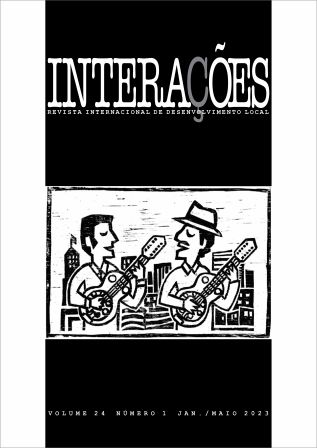Access to Urban Green Areas and Green Equity: a study in Campo Grande, MS
DOI:
https://doi.org/10.20435/inter.v24i1.3858Keywords:
Green Equity, Social and Environmental Vulnerability, Space Syntax, Environmental Justice, Urban ForestAbstract
Green areas provide key ecosystem services for cities. Such benefits, however, need to be distributed in the urban fabric so that they are equally accessible to all citizens, a principle called green equity. This study analyzed the distribution of green areas in the eleven neighborhoods of the urban region of Prosa, in the city of Campo Grande, capital of the state of Mato Grosso do Sul, through vector data provided by the Municipal System of Indicators (SISGRAN) of the Municipality of Campo Grande (PMCG). The region's green areas and road transport network were analyzed using the Space Syntax plugin and thematic maps generated in QGis and then compared with data on the income distribution of the region's residents. The results made it possible to point out the occurrence of spatial segregation in the region in relation to access to green areas by residents. It was observed that most of the green areas are located in the neighborhoods with higher income and with privileges of displacement and access by the main roads of the region. The opposite occurred in part of the neighborhoods with lower per capita income, with variation in occurrence and access to vegetated areas. This research could, therefore, verify the positive correlation between income and access to green areas in 72% of the analyzed neighborhoods, validating the analysis methodology.
References
ALMEIDA, W. M. M.; GUARALDO, E. Urban Green Equity: OVERVIEW of Scientific Research from 1992 to 2021. Life Style, São Paulo, v. 8, n. 2, p. 64–74, 2021.
BRASIL. Ministério da Integração e do Desenvolvimento Regional. Carta Brasileira Cidades Inteligentes. Brasília, DF 2020. Disponível em: https://www.gov.br/mdr/pt-br/assuntos/desenvolvimento-urbano/carta-brasileira-para-cidades-inteligentes/20201208_carta-brasileira-para-cidades-inteligentes_final.pdf. Acesso em: 25 mar. 2021.
CHEN, Y.; YUE, W.; LA ROSA, D. Which communities have better accessibility to green space? An investigation into environmental inequality using big data. Landscape and Urban Planning, [s.l.], p. 204, 2020.
UNITED NATIONS HUMAN SETTLEMENTS PROGRAMME [UN-HABITAT]. World cities report 2020: the value of sustainable urbanization. United Nations [s.l.], 2020. Disponível em: Disponível em: https://unhabitat.org/sites/default/files/2020/10/wcr_2020_report.pdf. Acesso em: 25 mar. 2021.
HILLIER, B.; HANSON, J. The social logic of space. New York: Cambridge University Press, 1984.
INSTITUTO BRASILEIRO DE GEOGRAFIA E ESTATÍSTICA [IBGE]. Panorama, Campo Grande/MS. Portal IBGE, Rio de Janeiro, 2022. Disponível em: https://cidades.ibge.gov.br/brasil/ms/campo-grande/panorama. Acesso em: 10 maio 2022.
INSTITUTO BRASILEIRO DE GEOGRAFIA E ESTATÍSTICA [IBGE]. Censo Demográfico 2010: Sinopse. Portal IBGE, Rio de Janeiro, 2010. 261p. Disponível em: https://biblioteca.ibge.gov.br/visualizacao/livros/liv49230.pdf. Acesso em: 12 set. 2021.
KOO, B. W.; BOYD, N.; GUHATHAKURTA, S.; BOTCHWEY, N. Environmental Equity and Spatiotemporal Patterns of Urban Tree Canopy in Atlanta. Journal of Planning Education and Research, [s.l.], v. 43, n.1, p. 166–81, 2019.
MACEDO, J.; HADDAD, M. A. Equitable distribution of open space: using spatial analysis to evaluate urban parks in Curitiba, Brazil. Environment and planning B: planning and design, [s.l.], v. 43, n. 6, p. 1096–117, 2016.
NATURAL ENGLAND. Climate change adaptation indicators for the natural environment. www.naturalengland.org.uk. Sheffield, 2010. Disponível em: https://webarchive.nationalarchives.gov.uk/ukgwa/20150902180000mp_/http://publications.naturalengland.org.uk/file/95015. Acesso em: 24 jul. 2022.
NATURE BASED SOLUTIONS INSTITUTE [NBSI]. The 3-30-300 Rule for Healthier and Greener Cities. NBSI, [s.l.], 2020. Disponível em: https://nbsi.eu/coworker/cecil-konijnendijk/. Acesso em: 30 jul. 2022.
NESBITT, L.; MEITNER, M. J.; SHEPPARD, S. R. J.; GIRLING, C. The dimensions of urban green equity: a framework for analysis. Urban Forestry and Urban Greening, [s.l.], n. 34, p. 240–8, 2018.
P̈CKE, S. R.; ALDUNCE, I. M. F. Distribution, size and accessibility of green areas in Santiago de Chile. Eure, v. 36, n. 109, p. 89–110, 2010.
BRASIL. Ministério do Desenvolvimento Regional. Bases para a atualização colaborativa da
Agenda Nacional de Desenvolvimento Urbano Sustentável – Política Nacional de Desenvolvimento Urbano [PNDU]. Brasília, DF 2021. Disponível em: https://www.gov.br/mdr/pt-br/assuntos/desenvolvimento-urbano/politica-nacional-de-desenvolvimento-urbano/PNDU_TextoBase.pdf. Acesso em: 19 maio 2022.
SISTEMA MUNICIPAL DE GEOPROCESSAMENTO [SIMGEO]. Cidadão. Campo Grande, 2022. Disponível em: https://simgeocidadao.campogrande.ms.gov.br/. Acesso em: 1º julho de 2022.
STEENBERG, J. W. N.; MILLWARD, A. A.; DUINKER, P. N.; NOWAK, D. J.; ROBINSON, P.J. Neighbourhood-scale urban forest ecosystem classification. Journal of Environmental Management, [s.l.], n. 163, p. 134–45, 2015.
UNITED NATIONS [UN]. General Assembly (70th sess.: 2015-2016). Transforming our world: the 2030 Agenda for sustainable development. New York, United Nations, 2015. Disponível em: https://digitallibrary.un.org/record/1654217?ln=en . Acesso em: 4 dez. 2021.
WOLCH, J.; WILSON, J. P.; FEHRENBACH, J. Parks and park funding in Los Angeles: an equity-mapping analysis. Urban Geography, [s.l.], v. 26, n. 1, p. 4-35, 2005.
Downloads
Published
How to Cite
Issue
Section
License
Copyright (c) 2022 WANDA MAIRA MUNIZ ALMEIDA, Ronaldo Oliveira Fernandes, Eliane Guaraldo

This work is licensed under a Creative Commons Attribution 4.0 International License.
Direitos Autorais para artigos publicados nesta revista são do autor, com direitos de primeira publicação para a revista. Em virtude de aparecerem nesta revista de acesso público, os artigos são de uso gratuito, com atribuições próprias, em aplicações educacionais e não-comerciais.


